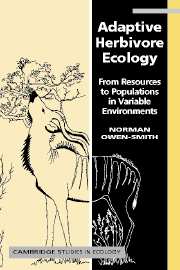Book contents
- Frontmatter
- Contents
- Acknowledgements
- Acronym and symbol conventions
- 1 Conceptual origins : variability in time and space
- 2 Consumer–resource models : theory and formulation
- 3 Resource abundance : intake response and time frames
- 4 Resource distribution : patch scales and depletion
- 5 Resource quality : nutritional gain and diet choice
- 6 Resource constraints : physiological capacities and costs
- 7 Resource allocation : growth, storage and reproduction
- 8 Resource production : regeneration and attrition
- 9 Resource competition : exploitation and density dependence
- 10 Resource-dependent mortality : nutrition, predation and demography
- 11 Habitat suitability : resource components and stocking densities
- 12 Resource partitioning : competition and coexistence
- 13 Population dynamics : resource basis for instability
- 14 An adaptive resource ecology : foundation and prospects
- References
- Index
11 - Habitat suitability : resource components and stocking densities
Published online by Cambridge University Press: 04 February 2011
- Frontmatter
- Contents
- Acknowledgements
- Acronym and symbol conventions
- 1 Conceptual origins : variability in time and space
- 2 Consumer–resource models : theory and formulation
- 3 Resource abundance : intake response and time frames
- 4 Resource distribution : patch scales and depletion
- 5 Resource quality : nutritional gain and diet choice
- 6 Resource constraints : physiological capacities and costs
- 7 Resource allocation : growth, storage and reproduction
- 8 Resource production : regeneration and attrition
- 9 Resource competition : exploitation and density dependence
- 10 Resource-dependent mortality : nutrition, predation and demography
- 11 Habitat suitability : resource components and stocking densities
- 12 Resource partitioning : competition and coexistence
- 13 Population dynamics : resource basis for instability
- 14 An adaptive resource ecology : foundation and prospects
- References
- Index
Summary
This chapter initiates the third section of this book, illustrating applications of the GMM model to particular issues in herbivore ecology and management. We address first the assessment of habitat suitability, as manifested by the abundance or performance of a herbivore population in a particular region. Wildlife managers usually think of the habitat ‘carrying capacity’, or maximum population that can be sustained. Livestock ranchers seek the optimal stocking density that would yield the highest production of meat, wool or other products. Caughley (1976b) termed the former ‘ecological carrying capacity’, the latter ‘economic carrying capacity’. Theoretical ecologists symbolize the zero growth density by the constant K in the logistic equation (May 1981), while acknowledging its vague reality. Ecological analysis has focussed largely on the feedbacks regulating populations around some density (Sinclair 1989). Less attention has been paid to the environmental determinants of the density attained.
The basic utility of the ‘carrying capacity’ concept was questioned by McLeod (1997) for real-world environments where population abundance fluctuates widely over time. Is it represented by the mean density? The peak density attained between disrupting events? Or by some remote upper level, rarely reached (cf. Ellis and Swift 1988)? Densities also differ widely regionally, and change numerically with enlargements in the scale of the area encompassed (Pastor et al. 1997).
Many factors contribute to habitat suitability, including not only the availability of suitable food and other resources, but also shelter from extreme conditions, and security against predators and other hazards.
- Type
- Chapter
- Information
- Adaptive Herbivore EcologyFrom Resources to Populations in Variable Environments, pp. 232 - 263Publisher: Cambridge University PressPrint publication year: 2002
- 1
- Cited by



